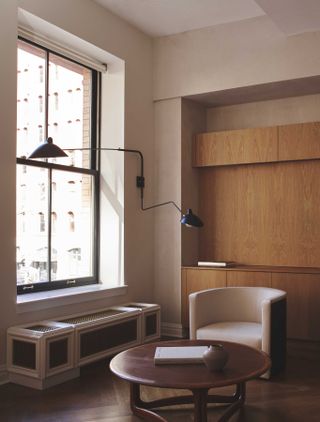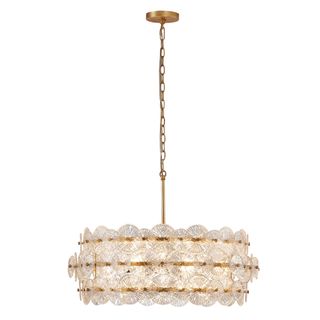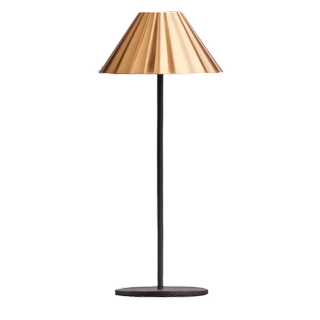As the most lived-in room of the home, your living room lighting ideas have to be versatile. They should include a combination of ambient, task, and accent lighting, which essentially means a mix of ceiling, table, and floor lights. With care and consideration of your lighting design, this primary space can serve many functions, from relaxing and reading to entertaining and socializing.
Knowing how to plan a living room lighting scheme can hugely improve the look and feel of your space, while a poor one can break it. You’ll be surprised how much of a difference living room lighting ideas can have on the mood of the space — like the simple addition of a warm floor lamp, or how a couple of sconces can add a whole new layer to your lounge.
To uncover the best living room ideas with layered lighting that’s effective, functional, and mood-boosting all at once, we asked designers for their tips on how to illuminate this integral part of the home. Here’s what they had to say.
1. Make use of floor lamps
(Image credit: August / Interior Mallorca Fotografia)
In the living room, lamps take precedence over everything else. There’s no place in the home where the rule against the infamous “big light” feels more pertinent. So, before you go diving into bright living room ceiling light ideas, start with a stylish floor lamp instead.
“You should always supplement your main light source with an array of lamps for that all-important layered lighting scheme,” says interior designer Emma Deterding, founder and creative director of Kelling Designs. “Make sure you have ample light for various tasks — for instance, by an armchair to create a reading nook — and you’ll ensure all of your lighting needs are fully covered.”
They’re a great way to fill in gaps around the room, too. If you have an empty-looking corner in your living room, for example, a floor lamp is the perfect solution.
2. Highlight shelving or artwork with gallery lights

(Image credit: McGee & Co)
Now, you can move your lighting ideas from the floor to your eye line with some decorative accent lighting. One thing you’ll always notice in the most elevated spaces are wall lights of some description, and gallery lights (otherwise known as picture lights) are a particularly chic addition to any living room.
This traditional style of lighting takes its name from the fixtures you often see in galleries where they’re used to spotlight art on the walls. Use them in a similar way, either above your favorite wall art or above built-in shelveing for a cozy living room idea that highlights a characterful collection of decor.
“For those with open shelving or curated displays, gallery lights can be a beautiful touch,” notes Jo Plant, Head of Design at lighting brand Pooky. “A gentle glow above your favorite artwork brings that high-end gallery vibe to your living room.”
3. Layer your lighting for a nuanced scheme

(Image credit: Shade Degges. Design: Medium Plenty)
When planning your living room lighting ideas, the trick is to make sure it’s layered. Relying on just an overhead or uniform wall lights will result in a flat space that lacks dimension. Instead, think laterally and add lighting sources all around, from top to bottom. That includes ambient lighting from the ceiling, task lighting from lamps, and accent lighting through sconces or backlights.
Karolina Wierzbicka, head of design at luxury property service August, notes that this will help balance cool and warm lighting in a living room, too. “Use warm ambient lights for a cozy feel, and add cooler task or accent lighting to highlight art or specific areas,” she says. “This mix creates a dynamic, inviting space that feels both comfortable and visually engaging.”
4. Consider a chandelier as the centrepiece

(Image credit: Design by Tone Kroken. Owner Confettibird. Photo credit Filippa Tredal)
There’s no lighting quite as show-stopping as a chandelier, and these fixtures make a classic choice for a living room. While we’ve emphasized the importance of side lights, a ceiling light is still essential in a living room, and chandeliers have always been a popular living room trend.
Apart from their glam and eye-catching aesthetic, they play a valuable role in the interior. Chandeliers produce ample light (often quite flattering), provide an anchor and a focal point in a room, and can make a room feel intimate yet grand. But don’t just take it from us. “They provide both sculptural beauty and functional lighting,” explains Helen Pett, brand ambassador at Arteriors.
When choosing the perfect chandelier for your space, she says it’s a case of balancing scale, texture, and finish. “Oversized pendants make a bold impact, especially when hung lower over a central coffee table, drawing the eye and creating a sense of intimacy. Look for designs with unique materials, think hand-forged metals, smoked glass, or natural textures like woven rattan, to introduce depth and character.”
5. Choose patterned shades for a whimsical touch

(Image credit: Pooky)
Living rooms aren’t usually lacking in soft textures or patterns. Upholstery, rugs, and curtains typically offer enough metaphorical “cushioning” to soften a space and add warmth, color, and interest. If you want to bring in even more, however, look to your living room lighting ideas and add patterned pleated shades.
The pleated lampshade trend rose to prominence a few years ago, drawing on traditional lighting ideas for a classic look. Their popularity hasn’t faded, though, and they offer a timeless elegance when used in a living room, whether grounded by a more neutral background or alongside other motifs for dramatic pattern clashing. “Think bold florals, rich textures, or playful stripes that catch the eye and add a pop of color without commitment,” says Jo Plant. “You can always swap back if you want to go for a neutral style again.”
6. Mix materials and hardware

(Image credit: And Studio)
There really is no limit to how many lights you should have in a living room, but they should all differ. It’s a good idea to incorporate a mix of materials and hardware for a characterful look that isn’t too uniform or “matchy-matchy”. If you’re using matt black hardware for your sconces, for example, consider a lustrous brass for your overhead fixture.
“For a modern edge, try a sleek metallic or glass finish, while softer, organic materials work beautifully in more relaxed or transitional spaces,” says Helen Pett. You should change the look and feel of each lighting component throughout the space, too. “Whether it’s a single striking piece or a grouping of pendants at varying heights, the right lighting can elevate a living room from ordinary to exceptional, creating a warm, inviting space that feels complete,” adds Helen.
7. Or match your materials for a uniform feel

(Image credit: Pooky)
That being said, for a more cohesive look, there’s no harm in choosing one recurring motif that runs throughout all your lighting ideas. That might be the material you use, such as rattan, or the hardware finish, like antiqued brass, for example.
“Curating this consistency through the chosen materials of your wall lights, ceiling lights, and accent lighting will create an effortlessly contemporary feel and a subtle sophistication to any living space,” says Mara Rypacek Miller, founder of Industville, a brand specializing in modern lighting solutions.
For a look that will endure, Mara suggests timeless fittings made from glass or refined metals. “Consider an elegant diffuser wall light and knurled table lamp, both in a shining brass finish to create a soft, ambient glow that will add warmth to the room,” she says. “Finish the look by incorporating accessories in the same finish, such as sculptures and vases on coffee tables or shelving. This will further cement the aesthetic unity in the design.”
8. Add a delicate touch with a thin pendant

(Image credit: Bespoke Only. Photo credit John Daniel Powers)
Pendants are those charming fixtures that hang from a ceiling via cords, chains, or poles, and are essential to a well-layered lighting plan. These not only double as task lighting when needed, but also offer a prime opportunity to put a decorative flourish to a space.
“There are many ceiling-mounted fixtures that are decorative and can work well over a sofa or coffee table,” says Clare Turner, owner and creative director of CTO Lighting. “Don’t be afraid to add drama by having a long drop rod. If you don’t walk under it, it’s not an issue. Support the decorative piece with concealed architectural lighting that will make the room feel larger.”
9. Try wall lamps to add balance

(Image credit: Studio Zung. Photo credit Adrian Gaut)
Wall light ideas make a great addition to a living room, contributing to a more nuanced scheme by illuminating the very foundations of the space. They’re especially useful in small living room ideas where they make a great alternative to a large statement piece, according to Massimiliano Tosetto, managing director of lighting brand Lodes. “Instead, subtle wall lamps won’t obstruct the room to diffuse light evenly,” he says.
In more generous-sized living rooms, sconces still complement wider lighting schemes. “It’s best to consider how each different type of light can work together to produce the amount of brightness you need in the room,” says Rohan Blacker, founder of Pooky. “Wall lights in particular are a stylish and flexible option for a living room, great if space is at a premium and a perfect additional light source for layering with the ceiling and mid-level lighting.”
10. And use sculptural wall sconces specifically

(Image credit: Industville)
Sconces are small yet highly effective pieces that can offer the perfect balance between form and functionality while demanding very little. But, if you want to use yours to make more of a statement, choose a sculptural design like the one pictured above for an elegant living room idea that looks really high-end.
When it comes to the positioning of wall lights in the living room, however, do keep a few things in mind. “There are no hard and fast rules, but be careful where you put them and at what height,” says Emma. “The objective is to light the room and not the ceilings — many people install them way too high. Consider whether the wall light points up or down, and then decide on a height.”
The number of wall lights should also strike the perfect balance, too. “The number can be determined by the furniture placement,” says interior designer Joy Moyler. “Take into account where people will be sat — during the conversation you want to see the person’s face and be able to look into their eyes. If the space is too dark, it feels intimidating.”
11. Add task lighting with table lamps

(Image credit: August /Interior Mallorca Fotografia)
In a living room dominated by pendant lighting ideas or wall sconces, you may think the need for a table lamp is low, but don’t underestimate what this piece can do for a room. When used right, a table lamp can bring symmetry, color, contrast, and texture and offer focused illumination.
“The more sources of light you have, the more moods you can create,” says Rohan. “Cluster a few small lamps to add impact to an alcove or mantelpiece, or if you have the space use pairs of lamps to create some formality and frame pieces of furniture or art.”
“Choose table lamps that are 27-30 inches high to provide a good light wash, and think about using a shade with a gold interior or liner to create a warm, flattering light,” adds Joy. “In darker spaces, use a natural or white lining to add more light.”
12. And consider making them rechargeable

(Image credit: Pooky)
While they help to set the mood and complement your overall ambient lighting, table lamps are often used for task lighting in a living room, be that reading or illuminating your coffee table or writing desk. With so many versatile uses, it makes sense to have a table lamp that’s versatile in nature, which is why wireless, rechargeable options make the best table lamps.
“Wireless lamps are a fantastic option if you’re craving flexibility and an instant refresh,” says Jo. “Try placing them on a side table, windowsill, or even nestled within a bookshelf to bring that cozy glow right where you want it.” Wherever it is you need some extra light, your lamp can follow, and you can easily change up the look of your living room at the flick of a switch.
13. Highlight a special feature with recessed lights

(Image credit: Baldiwala Edge)
Use recessed lighting to draw attention to a particular area of the living room. Say you have a wonderful gallery wall, a sculpture, or a ceiling molding you want to spotlight, you can do so with recessed lights that throw a soft yet attention-grabbing illumination at these elements.
“Recessed lights are perfect for creating a sleek, streamlined look, and opaque glass shades can gently diffuse light, helping to soften any harsh lines,” says Claire Anstey of Heal’s. This style of living room lighting lends itself especially well to a more modern look, if you have a more contemporary taste.
14. Walk the green path with LED bulbs

(Image credit: August / Pete Helme Photography)
There are many benefits to swapping out your incandescent lightbulbs for LEDs. Not only will you be saving money on your electric bill, but you will also receive superior light quality that has less impact on the environment. You’ll also only need to replace these bulbs once every decade or two instead of every few months.
If you’re going the LED way, consider smart light bulbs that are easy to use and make the home an automated miracle. “Use indirect light to avoid harsh glare and use the ceiling and walls to bounce soft light into the space rather than directly lighting,” says Will Earl, design director of lighting brand J Adams & Co. “Go for high quality, warm white LED bulbs which are dimmable, preferably with a high CRI value.”
15. Bring in spotlights on a dimmer

(Image credit: Jan Pokotilo)
Another subtle yet important lighting element is spotlights which throw general illumination into the room. They’re a great way of lighting a living room without a sole ceiling light and due to their tiny size they can be installed anywhere around the room; on the walls, ceiling, or even on wall-to-wall wallpaper.
They work best on a dimmer which can be brightened up for tasks but lowered to create a moody interior. In fact, dimmer switches or bulbs are preferable for all modes of lighting.
“They’re a fantastic tool to have in every room but particularly key for your living room, to give you options for every occasion as it’s such a multi-functional space,” advises Rohan.
FAQs
How do you get your living room lighting right?
The best living room lighting ideas are considered holistically, taking into account the room’s main purpose, the furniture placement, and the various modes of lighting that will also factor in. Most of us use our living rooms to switch off (metaphorically, that is — lighting should still play a part!). This means we should look to create a cozy space through our lighting.
“The living room is where you want to spend your time after a long day; somewhere comfortable and cozy to entertain friends, have a glass of wine, or read a book on the sofa,” says Fiona Blanchot, director at Studio Ashby. “It’s so important that the light level supports you in winding down from the day.”
You should also consider the placement to avoid any lighting mistakes. “The fixtures you use are crucial to the overall design scheme and should be planned at the beginning of the design process,” says Emma. “This will ensure you have switches, wiring, and light fixtures in all the right places to create the perfect, layered lighting scheme.”
How do you layer lighting in a living room?
Layered lighting will give your living room more versatility, allowing you to change its purpose from functional to practical to decorative at the flick of a switch. “Think about the different heights of your light sources, and various zones and surfaces,” says Will. “Use a mixture of light sources at multiple levels, and different types of light (direct and indirect light sources; ceiling and floor, wall and table lights) to create an ambient background light level which you can then layer on top of by highlighting features and surfaces to create drama.”
“It’s important to consider the various functions of the room and layer both ambient and punctual lighting to cater to different needs,” adds Massimiliano. “Ambient light sets the mood, punctual light serves reading and working purposes. The former can be generated through wall sconces, ceiling fixtures and spotlights, while suspension, reading and table lamps can respond to direct light needs.”
Should living room lighting be practical or ornamental?
Before diving into any fleeting lighting trends, think about the longevity of your choices. Good light has to multitask, ticking both the practical and beautiful boxes, but as a more costly design element, you also want it to last you for years to come, so be sure to choose something timeless rather than a short-lived aesthetic.
In terms of function versus decorativeness, however, you want it to do both. “Practical and ornamental aspects should be considered together to ensure that lighting serves its purpose switched on but still delights as a piece to be admired when switched off,” says Rohan.
That said, there’s less need for practicality in a living room, so your lighting won’t take as much of a precedence as it would in, say, a kitchen. “But, by mixing ornamental and decorative lighting, you can create something flexible and therefore practical, with the addition of more technical reading lamps where needed,” says Joy. This will offer you the best of both worlds, meeting all your possible needs.

(Image credit: A New Day)














